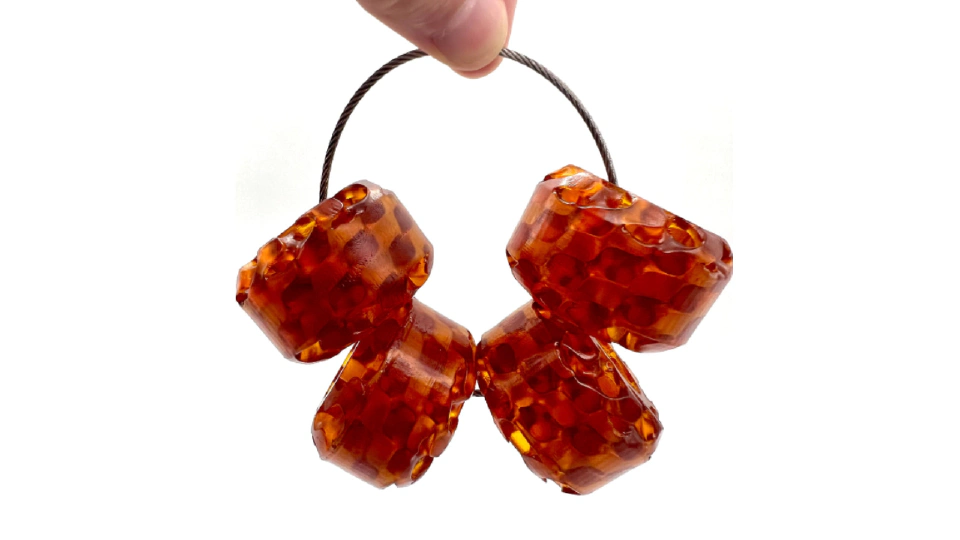Additive manufacturing has come a long way in the past decade, with more and more material processes and options reducing the cost of producing high-quality, functional, and attractive prototypes and production run parts.
With ever-increasing levels of precision and a wider range of functional 3D printing materials available, combined with greater accessibility to CAD tools, an individual doesn’t need to break the bank to quickly realize the development of a product from an idea.
SuliSkate
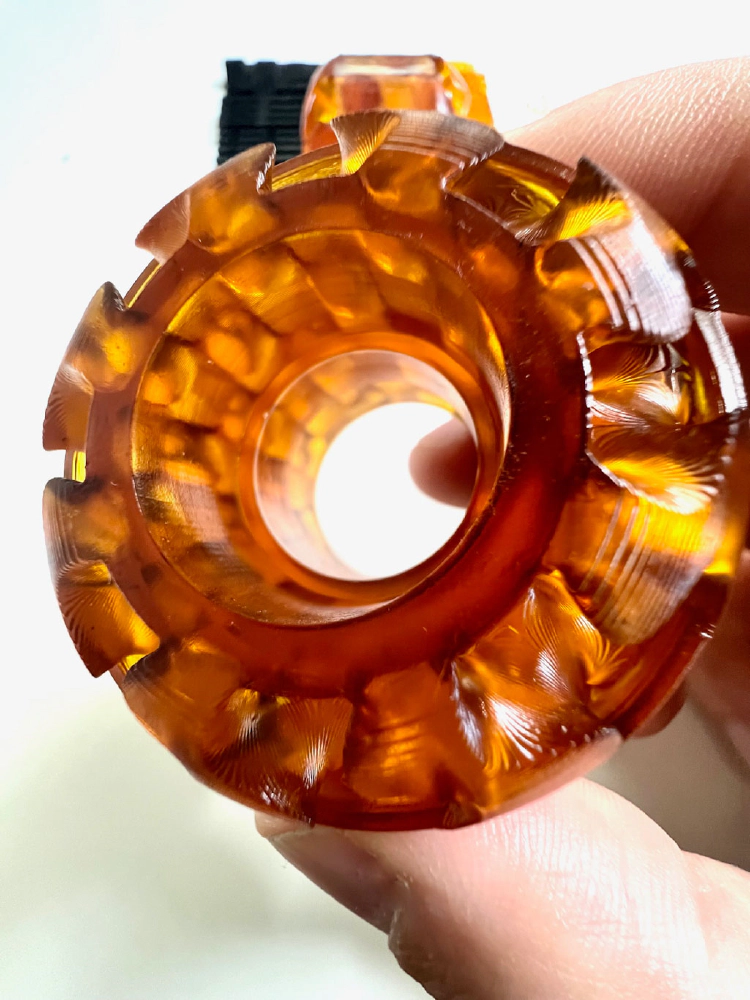
This is the case with the SuliSkate, the world’s first commercially available 3D printed skateboard wheel. It was designed with the Gen3D design software to assist with lightweighting, and printed with COR Alpha resin for maximum ruggedness.
Naturally, ruggedness and impact resistance are desirable properties for a skateboard wheel.
Why Is Lighter Better?
Gen3D is the developer of a DfAM / lattice creation software suite named Sulis.
Sulis contains two lattice optimization modules called Sulis Lattice and Sulis Flow, which are used for generating lightweight lattice structures and for creating flow channels for heat exchangers, respectively.
The lattice wheel idea evolved from a project started by Steven Goguelin, one of Gen3D’s R&D engineers, who had wanted to try their own lattice software to create a lightweight but strong skateboard wheel.
You can see Steven’s original rendering in the image below.

When our engineers at polySpectra saw the rendering of the latticed wheels on social media, they reached out to the designer to see if our rugged COR Alpha resin could assist in realizing his design.
After all, COR Alpha offers best in class impact strength…and what better way to demonstrate than with a few jumps (and landings) on a skateboard!
With a few tweaks to the design from polySpectra to make it manufacturable with resin printing, the first wheels were printed in glorious translucent-amber COR Alpha, as you can see below.
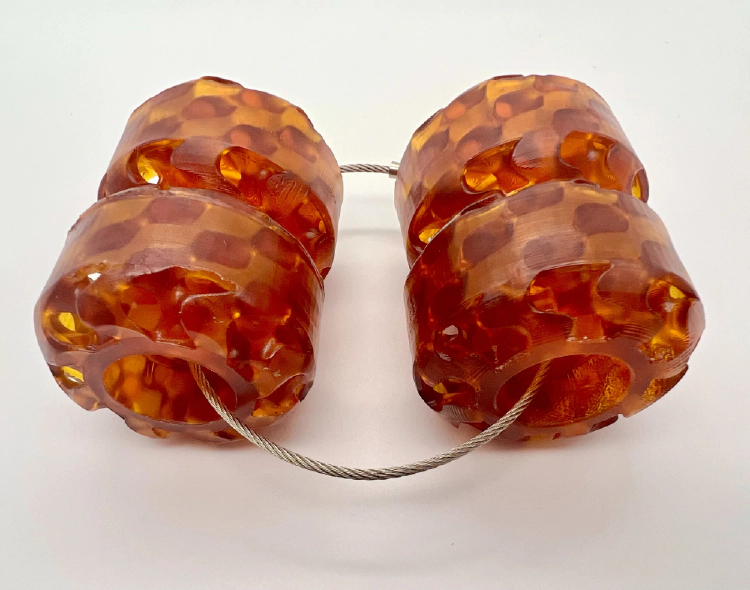
Thanks to the geometry generated in the software and the strong plastic, each wheel weighs about 30 grams, which is less than half the weight of a traditional wheel.
And of all the types of 3D printing processes available, high-speed resin printing processes such as DLP make it possible to not only produce quality, functional prototypes but larger, commercial-sized production runs fit for retail.
Gyroid
To create the lightweight SuliSkate wheel, 3D gyroid structures were used to create voids within the wheel, reducing the mass while retaining strength.
Geometrically speaking, a gyroid is an infinitely connected periodic minimal surface containing no straight lines.
What that means in non-technical terms is that gyroids are very efficient structures, offering great strength and low density. It has been shown that a gyroid has a higher resistance to bending per unit mass (and higher specific strength) than a honeycomb structure, and this is why so many makers and engineers choose to use it as infill patterns for general 3D printing.
And let’s be honest - gyroids look kinda pretty, especially when printed in rugged, translucent amber.
You can see the details of a typical gyroid structure in the picture below. This example was printed in metal and shows the features of gyroid geometry.
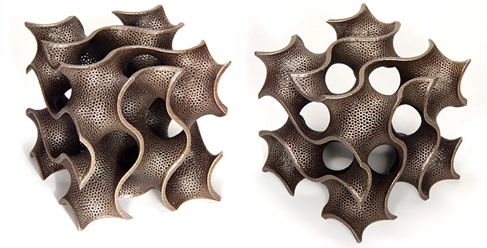
Typical gyroid structure
Making Wheels the Old Way
Typically, skateboard wheels are molded from polyurethane plastic. After being poured into molds via a nozzle dispenser, they are sent to an oven for curing. The cured parts must then be removed from the molds before further quality controls and post-processing make the parts ready for the customer.
It’s quite a hands-on process and results in fully dense solid parts.
While it’s true that solid parts are strong parts, it also means that they are heavy parts, and this is true in every industry, be it aerospace, automotive, or skateboard design.
By manufacturing the wheels with COR Alpha and 3D printing technology, the manufacturing steps are reduced significantly.
In fact, unlike polyurethane 3D printing resins, COR Alpha doesn’t require additional curing. Parts printed with COR Alpha are, from a materials standpoint, ready to use right out of the printer.
You can see the wheel design in action in the video below. Or pick up your own 3D printed skateboard wheels.
Hardness
The hardness of the plastic used in the wheels directly affects the performance and handling of the skateboard.
Harder wheels are much faster and responsive but are a much bumpier ride as they feel every bump on the ground. They also wear down at a much slower rate compared to softer wheels.
Softer wheels are better at gripping the floor and offer a more comfortable ride, especially on bumpy ground. The softer material effectively damps vibration from the ground. This extra ride comfort and grip comes at a cost. Softer wheels are slow, and they wear a lot faster.
The SuliSkate wheel printed with the COR Alpha 3D printing polymer has a Shore D hardness rating of 84D. This makes it a very hard plastic indeed. So hard that it actually can’t be converted to a Shore A rating because the Shore A scale only goes up to 100!
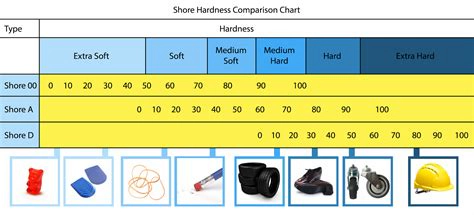
Credit - http://therubbercompany.com
This means that the SuliSkate is better suited for high speeds on smooth ground, such as a concrete skatepark.
Impact Strength
Impact is what happens when a large force is applied over a short period of time.
When you jump off a ramp on a skateboard and land, your wheels take the brunt of that impact, so it is important to find a plastic with suitable impact resistance.
COR Alpha has a very high impact strength rating of 35 J/m, making it one of the most impact resistant plastics of its type and making it perfect for applications where the plastic parts are sure to take a beating- applications such as 3D printed skateboard wheels are one such example!
Strongest Material for 3D Printing In Action
The total time needed from concept to market took just a few months and produced a product that would have been impossible to manufacture just a decade ago.
With all of these wonderful tools available to us in Industry 4.0, the sky is really the limit in terms of manufacturing.
If you could optimize something and print it in a rugged, accurate resin such as COR Alpha, what idea would you like to make real?
If you have a product idea like engineer Steven Goguelin did, and would like to see it manufactured with our rugged resin, be it for prototype or production, then feel free to reach out to us, and we will be glad to discuss how we can help.

